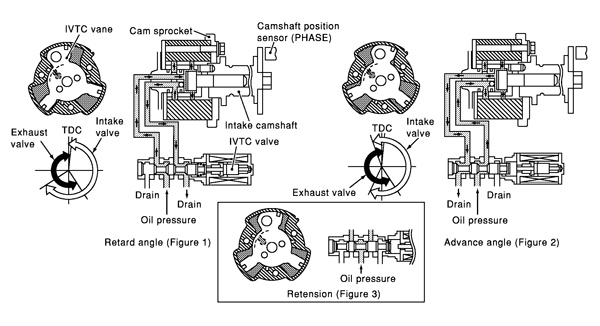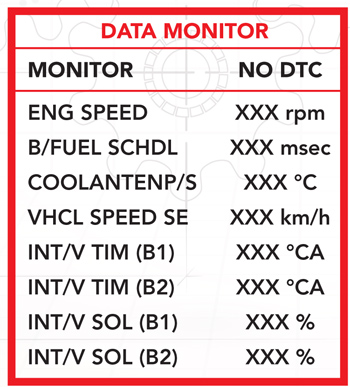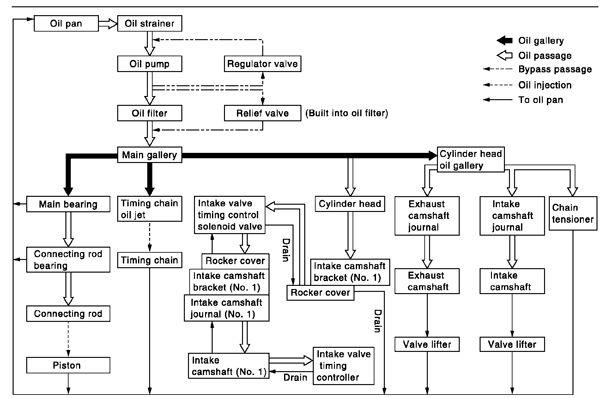As import specialist techs, we know how important camshaft timing is to the performance of an engine. Many of us have spent hours with degree wheels and dial indicators in order to get precise cam timing so that an engine could perform better in the desired RPM range. Having used offset keys and bushings, or if we’re lucky, adjustable pulleys, we would instead spend that time making changes as small as two degrees, resulting in performance improvements at the desired RPM range, while costing some performance issues in other ranges.
As you would expect, the engineers who design engines for Nissan are well aware of the performance increases available with cam timing. While the hot rodders are concerned only with performance, the engineers’ task is to deliver economy, driveability, low emissions and performance. These engineers were quick to take advantage of advanced electronic and computer controls that have opened up the opportunity to use a variable cam timing system.
While the early systems would change the timing only on the intake side, later systems handled both cams, and work continues as we move to variable valve lift. Throw in variable intake tracts and it becomes obvious how important volumetric efficiency is to reaching the goal of an economical, clean engine with good performance across the entire RPM range.
There is nothing new about the technology; Nissan was one of the first manufacturers to introduce variable valve timing in the late 1980s on the V6 engine in the 350Z, and now it’s used throughout its line. As import vehicle specialists, we are asked to deal with the system, both in a diagnostic, driveability role, as well as the mechanical aspect while performing engine service.
PERFORMANCE ISSUES
We’ll start with driveability, if that is actually a good description. It would take a sensitive driver to notice the drop in performance if the system wasn’t operating as designed. The complaint would more likely be “it just doesn’t feel right.” The good news is that any problem with the variable cam timing will result in a fault code setting the “service engine soon” lamp on the dash. For this article, we will look at Sentra 1.8L from the mid-2000s. Like any other diagnostic challenge, your first step should include checking the service information you have available, as well any other tech community forums that will assist in the process.
The system is really quite simple. There is a variable gear or sprocket mounted on the intake camshaft that adjusts the camshaft timing based on oil flow and direction. It’s controlled by the ECU by way of the two-wire valve timing oil control solenoid that’s mounted on the valve cover. The ECU looks at coolant temp, RPM, injector pulse and cam position sensor to make its decisions on where the cam should be, and if the system is working as expected.
Looking at these parameters, the ECU controls the oil flow by pulsing the ground side of the solenoid; the longer the pulse or duty cycle, the more the cam will advance, while a short duty cycle or on time cycle will retard the cam. Figure 1 shows how the solenoid plunger reacts to the duty cycle changes. As you can see, when the duty cycle increases, different ports are exposed, which changes both the amount as well as the direction of the oil. Keep in mind as you’re looking at the control signal that you’re looking at a duty cycle. It’s best to use a graphing meter or scope to see the changes. At idle, you’ll see little or no “on time,” but bring it up to 2,000 rpm on a warm engine and you should see a much longer on time — up to 50%. On this application, the signal wire is green with a yellow stripe. 
If the ECU doesn’t see the expected results, it will set a code, turn on the service engine soon lamp and the system will go into fail safe. The solenoid will not be energized. If you find yourself diagnosing one of these systems, it’s probably the result of one of the two codes that can be set. P0011 INT/V Timing Control means the camshaft timing did not change as the ECU expected. Or, there will be a P0075 code, indicating that the solenoid didn’t react electrically as expected.
CHECKING CODES
 Needless to say, if any other codes are evident, take care of them first. If the ECU is saying it can’t see the cam sensor, it only makes sense that it won’t know if the timing is changing. If you have access to a scanner with enhanced Nissan capabilities, don’t overlook the information available there.
Needless to say, if any other codes are evident, take care of them first. If the ECU is saying it can’t see the cam sensor, it only makes sense that it won’t know if the timing is changing. If you have access to a scanner with enhanced Nissan capabilities, don’t overlook the information available there.
What’s available will vary by model and scanner, so be sure to check live data parameters, as well as any work functions that will aid your diagnosis. Most enhanced scanners will give you intake camshaft advance in degrees, as well as percentage of solenoid on time.  Knowing that more on time equals more advance, a quick road test with the right parameter IDs gives you a good look at what’s going on. Figures 2 and 3 show what you would expect to see and how the parameters are listed. For this example, we’re looking at a V6 Maxima.
Knowing that more on time equals more advance, a quick road test with the right parameter IDs gives you a good look at what’s going on. Figures 2 and 3 show what you would expect to see and how the parameters are listed. For this example, we’re looking at a V6 Maxima.
We haven’t yet talked about what is really the heart of this system — good oil flow and pressure. Looking at Figure 4, you can see the path the oil has to travel to make it to the adjustable sprocket, and you can likely envision where the sludge would collect in a poorly maintained engine.  If you suspect an oil flow problem, remove the control valve and make sure the engine won’t start, unplug the coils and/or injectors, block the opening with a shop rag and have an assistant crank the starter as you watch for oil flow. Be careful as there should be good flow and you don’t want get a face full.
If you suspect an oil flow problem, remove the control valve and make sure the engine won’t start, unplug the coils and/or injectors, block the opening with a shop rag and have an assistant crank the starter as you watch for oil flow. Be careful as there should be good flow and you don’t want get a face full.
While the valve is out, a simple visual inspection should give you a good indication of the condition of the oiling system. If you want to work the valve while it’s removed, put 12 volts across the terminals to move the plunger. Remember, this solenoid works on a duty cycle; don’t leave it hooked up more than a couple of seconds at a time.
If you didn’t get any oil to the valve during the cranking test, you already know what you’re in for and it’s time to call the customer. You could check for oil pressure with a mechanical gauge, but the outcome won’t change the fact there’s no volume at the controller. While Nissans aren’t known to have problems with sludge, it can happen, especially if the owner missed a few oil changes.
I talk about systems like variable valve timing, hydraulic lash adjusters and complex timing chains as I remind my customers how important timely oil changes are to a vehicle. The topic seems to be coming up more often lately as the carmakers are extending oil-change intervals. I continue to tell them that if they can’t afford any other service, don’t skip oil changes. They surely cannot afford to not change the oil and deal with the cumulative damage that will result.
LOCKING THE CAM
When performing any service that has you working with the timing chain, camshaft or cylinder head, there are procedures that must be followed to prevent causing damage to the variable pulley. Below is the procedure to lock the cam in the most advanced position to facilitate cylinder head removal.
1. With the cam and front cover removed, it’s time to review the service info and remove the camshafts.
2. The first step is to bring the engine up to TDC. Always turning in the direction of rotation (clockwise), confirm that the timing marks are aligned and make your own marks on the chain to be used on reassembly.
3. Now it’s time to prepare the timing gears for removal. Nissan, like most manufacturers, uses oil pressure to adjust the cam timing. The intake cam is at the most retarded position when the engine is off, and has to be locked in the most advanced position for removal. Nissan uses an internal lock pin in the pulley to hold it in the most retarded position. This pin has to be released so you can put the cam in the advanced position and lock it there.
4. Apply air pressure to the rearmost oil port (advanced port) in the head where the valve timing control solenoid mounts. Listening closely, you can hear the internal pin disengage in the sprocket. Keeping the air applied, turn the cam clockwise with an open-end wrench on the hex part of the cam. Don’t force it; if the pin is released, the cam won’t be hard to turn. If necessary, “wiggle” the cam to dislodge the pin; the most stubborn cases may require some easy taps with a plastic hammer on the face of the gear.
5. You’ll know you’re at the most advanced position when the sprocket starts to move with the cam. At this point, insert a locking pin in the sprocket to lock the gear in the most advanced position. Your service information will describe the pin that’s required, but it’s basically an Allen wrench. Tape the pin in place to be sure it stays put.
6. Now the timing chain tensioner can be removed. The tensioner is a ratchet type and to release the ratchet, push down the release lever allowing you to push the plunger into body. At that point, insert a stiff wire through the lever into the tensioner housing to lock the release and plunger in place. Skip this step and you have a good chance of the plunger and spring ending up in the oil pan. These are all straightforward steps, but more proof that time reviewing a procedure in the service manual is time well spent.
In this article, we covered the simple system as used on the Sentra. Other systems are very similar, but don’t get too complacent since the engineers aren’t always looking for ways to get the best of both worlds. We’ll soon be dealing with Variable Valve Event and Lift (VVEL).
Using ECU-controlled stepper motors, valve timing and lift will be adjusted throughout the operating range to further improve volumetric efficiency. Using a variable rocker pivot, this system limits valve lift at low RPM, increases velocity to better fill the cylinder, and while at wide open throttle it will provide more lift than possible with a traditional camshaft. Sounds like better mileage and increased performance; as car guys we’ve got to like that! Search Nissan VVEL for more information and to stay ahead of the curve.
Diagrams are courtesy of Nissan, via Mitchell ProDemand.
